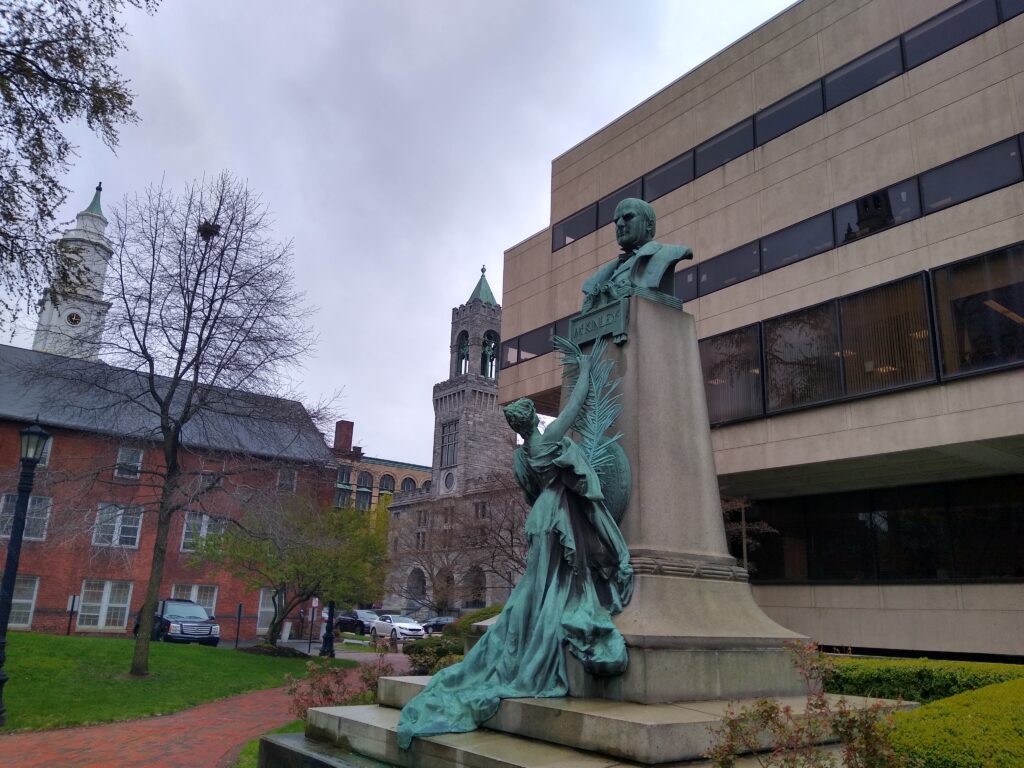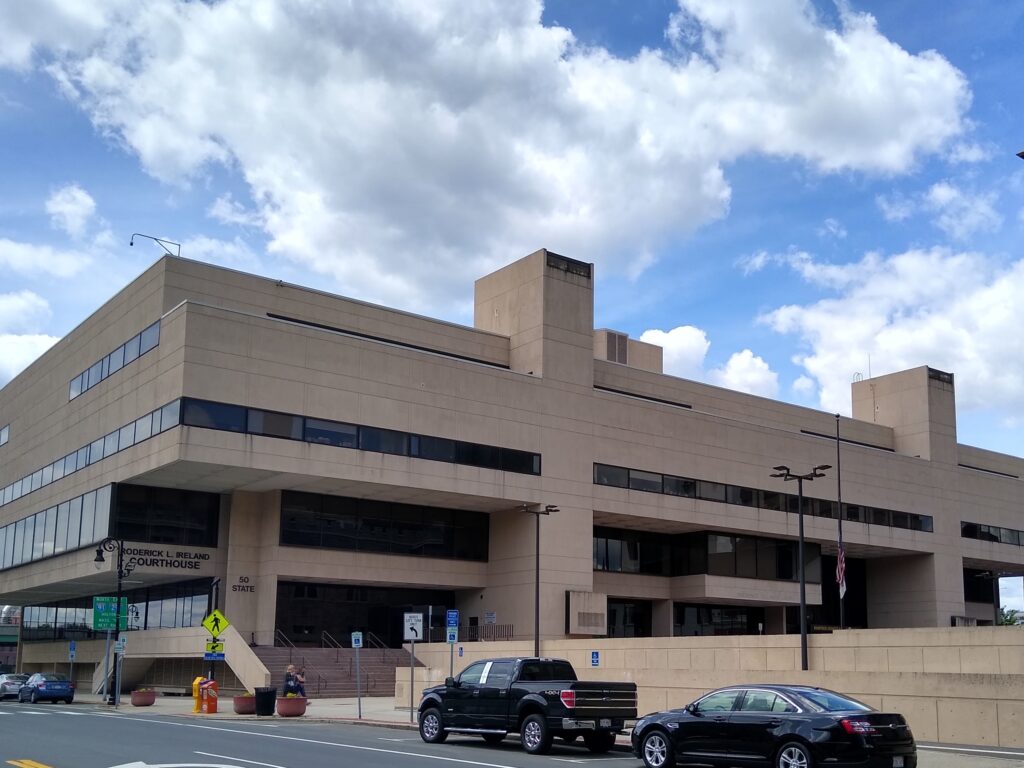Analysis: Springfield Courthouse Calamity about More than Bad Air…
The Roderick L. Ireland Courthouse in Springfield, seat of Springfield District Court, Hampden Superior Court and four of the county’s extant officers, is plainly a mess. Whether it is the antithesis of environmental health or just poorly maintained, pressure to replace it has never been greater. As if designed in the Brutalism style, only duller, no one will miss it.
It seems inevitable that the courthouse will see some movement. Springfield Congressman Richard Neal has called for federal inspections of the building. Whether Uncle Sam or some independent arbiter, the courthouse’s days feel numbered. But did it ever have to get to this point? The nerve center of the judiciary in Springfield is as much a monument to the state’s inability to plan, maintain and as necessary replace infrastructure.
While those pressing for a new courthouse have a point, many neglect their own institutions’ roles in this calamity. It is the political incentives in cities like Springfield and on Beacon Hill that allow such problems to fester as they have at the courthouse. Replacing it could become another showpiece in the fiasco that is Massachusetts’s management of its assets.
The Springfield courthouse is not even alone. Suffolk County’s glimmering art deco courthouse is in grave need of renovation. The Massachusetts Bay Transit Authority’s almost comical inability to avoid all matters of infrastructure failures is now legend. Few drivers realize that many tiny bridges over brooks and streams may not only be structurally deficient, but are a state responsibility.

We are not alone. (via Boston FD/WBUR)
The principal culprit in this is stinginess and refusal to compromise. Massachusetts is not a poor state. While federal funds are helpful or even necessary for the most ambitious projects, the commonwealth does not need them for everything. Whether through taxation or bonding, Massachusetts has the wealth to build and maintain a fleet of solid civic artifice.
Instead, things like courthouses, state buildings and bridges, to say nothing of their municipal analogs, are subject to byzantine processes and legislative sleights of hand. A procession of budget amendments and bond bills in the legislature places a teeming mass of needs at the mercy of Beacon Hill’s caesars. Or, try your luck with the grinding property management systems that takes care of the others.
Lawmakers and governors could do the responsible thing and raise the necessary funds from the public. The exchange would be promise of dutiful and efficient process. This is plainly possible. Whatever Governor Charlie Baker’s failures to conquer the MBTA’s embarrassments, his Excellency did save the Green Line extension from death by price tag thrombosis.
Ultimately, the problem is not money. Rather, it is a avoidance of decision-making, action and proactive thought. The commonwealth has a list of capital projects like any responsible entity would. However, the processes to work through the needs and stop problems before they become disasters are not working. Otherwise, Springfield’s courthouse may not have become an omnishambles.
It is perhaps possible that the building was doomed from the start—though such an analysis would be useful. Regular maintenance and monitoring of air quality, something especially in vogue amidst the pandemic, may have helped. It might have noticed diesel fumes, a speculated cause of the Lou Gehrig’s disease several courthouse denizens contracted, were getting out from the basement garage.
But such proactivity is not sexy. While some pols will attend the opening of an envelope, a ribbon cutting for new drywall or air ducts in a decades-old building does not jazz up of a reelection mailer. While it is hardly unique to Springfield, the state’s third city and many local and state official are ever-tempted by this impulse. That in turn makes creative and transformative thinking difficult. The dearth of it makes execution of ideas like East-West rail, only now coming into view after, confounding.
Another issue is that much maintenance of state assets falls squarely within the earmark process of budget bills and bonds. Pork is not evil. For the high-minded purist, such grease in the wheels of government is abhorrent. But it can also stabilize politics from dangerous extremes.
The issue is subjecting such projects to hyperlocal political whims and the Solomons that sit atop the House and Senate committees. Sometimes, these projects end up in a bond bill, which is not actually a guarantee work will ever commence. The governor hypothetically can block a bond bill item indefinitely. Not surprisingly, legislators leverage these processes rather than lobby the Division of Capital Asset Management & Maintenance, which reports to the governor.
It is not beyond the ability of legislature to do better. The Massachusetts School Building Authority, which funds school construction and renovation, is more coherent. Municipalities compete for state money available in varying amounts depending on their local match. It is not perfect and it helps to know the State Treasurer, who oversees the MSBA. Yet, determined school districts can reimagine their school fleets rather than relying on the holy trinity of speaker, senate president and committee chair.
Such a system could not work perfectly for state buildings. The state is not going to match itself and the MSBA has a dedicated revenue source (1% of the sales tax). Nor are the legislature and DCAMM or other state entities operating on completely out of sync. But if the status quo were working, nobody would be thinking about the courthouse.
The parochial needs of politicians, who would love to tout a plum like a new courthouse, do not always lend themselves to bureaucratic thinking. Agencies like DCAMM or the Judiciary’s operations division likely look upon calls for action from pols with some suspicion. That instinct is only stronger with a bureaucrat-in-chief like Charlie at the top, who balk at what a new courthouse could cost.
Spare few tears for the executive though. If the state had conceded the courthouse’s miasma, it could have to put everybody somewhere else. It’s hard to believe that there is not any excess office and event space for clerks and courtrooms. Yet, if the state does that, it all but concedes a new building or at least a costly renovation is inevitable.
From there enters the complications of local politics. The long parade of Springfield’s usual political suspects will jockey to jam their hands into the pie of a new building.
For reasons not entirely clear, there is an allergy to reusing the courthouse plot next to the casino. Perhaps back when everybody expected a development boom next to MGM, this idea deserved currency. But such a renaissance is not in the offing. Court Square suffered an indignity long ago when I-91 truncated it. Why rob it of its namesake?

Somehow the H.H. Richardson Courthouse, center, from 1871 has been less bedeviled than the modern one built a century later. (WMP&I)
But if it did move away from its historical home, the hairbrained are ready. Rather than tax-paying transit-oriented development, some players have applauded placing a tax-exempt judicial structure near the city’s gateway, Union Station. This is separate from the question of which well-connected monied interest gets to sell otherwise unmovable land to the state. Here is but a taste of the nimrodery and Faustian bargains the commonwealth must muddle through if it builds a new courthouse.
Something must happen at the courthouse in Springfield. But wherever the Massachusetts judiciary metes out justice in Springfield, another imbroglio like this could happen again. Indeed, countless others are happening that get less attention. It behooves leaders to find a better way to maintain and care for the structures both state workers and citizens alike utilize.


1 thoughts on “Analysis: Springfield Courthouse Calamity about More than Bad Air…”
Comments are closed.